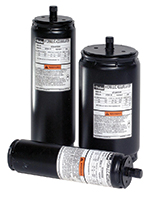
Webinar: Increasing Safety and Longevity of Wind Turbines Using Piston-Style Accumulators on Brake Systems
Wind turbines are designed to maximize power production at the plant location’s most probable wind speeds, which is usually in the range of 30 mph. While designing a wind turbine for higher wind speeds is typically uneconomical, high wind conditions are not uncommon at most wind farm locations. In these conditions, it is imperative to limit the power generated to avoid spontaneous runaway turbine situations which can lead to catastrophic failure due to overloading of rotors, the power train and electrical generators.
High speed shaft brake systems on wind turbines are vital for safety and protection of equipment from damage. Modern wind turbines incorporate hydraulic braking systems for this purpose, and a critical component of these hydraulic systems is an accumulator which provides supplemental flow of hydraulic fluid for fast response in braking. Currently, diaphragm style accumulators are the most widely used technology and are suitable for storing energy under pressure, hydraulic shocks, and dampening pump pulsation and flow fluctuations. However, when diaphragm accumulators fail it is a catastrophic type failure as typically the diaphragm will tear and completely release all the stored gas. The diaphragm failure mode is thus very sudden, as the pre-charged accumulator pressure instantaneously falls to zero.
An attractive alternative to diaphragm style accumulators is the crimped piston style accumulator which can be customized to each application for bore size, length, seals, gas valves, etc. The key advantage is the smaller volume of rubber susceptible to permeation, which extends life and greatly reduces brake system failures, downtime and pre-charge maintenance.
In this informative webinar, Parker's Tom Ulery will discuss the key technical and economic benefits of our crimped piston style accumulator.
Specific topics will include:
- The effects of high permeation rates on brake system failures
- Reducing downtime due to gradual vs. instantaneous failure
- ROI for utilization of ACP piston accumulators vs diaphragm type

Discover how Parker ABEX Jet-Pipe can benefit your application?
Submit the form below and a Power Generation & Renewables application expert will be in touch to discuss your challenges.

By Submitting This Information I Agree To Parker's Privacy Policy


